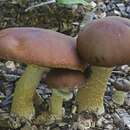en
names in breadcrumbs


Stropharia rugosoannulata, commonly known as the wine cap stropharia, "garden giant", burgundy mushroom or king stropharia (Japanese: saketsubatake), is an agaric of the family Strophariaceae native to Europe and North America. Unlike many other members of the genus Stropharia, it is regarded as a choice edible[2] and is commercially cultivated.
The king stropharia can grow to 20 centimetres (8 inches) high with a reddish-brown convex to flattening cap up to 30 cm (12 in) across, the size leading to another colloquial name godzilla mushroom.[3] The gills are initially pale, then grey, and finally dark purple-brown in colour. The firm flesh is white, as is the tall stem which bears a wrinkled ring. This is the origin of the specific epithet which means "wrinkled-ringed".[4]
The species is found on wood chips across North America in summer and autumn. It is also found in Europe, and has been introduced to Australia and New Zealand.
The mushroom was reported in April 2018 in Colombia, in the city of Bogota.
In Paul Stamets' book Mycelium Running, a study done by Christiane Pischl showed that the king stropharia makes an excellent garden companion to corn. The fungus also has a European history of being grown with corn.
A 2006 study, published in the journal Applied and Environmental Microbiology, found the king stropharia to have the ability to attack the nematode Panagrellus redivivus; the fungus produces unique spiny cells called acanthocytes which are able to immobilise and digest the nematodes.[5]
Described as very tasty by some authors, king stropharia is easily cultivated on a medium similar to that on which it grows naturally. Antonio Carluccio recommends sautéeing them in butter or grilling them.[3]
It is illegal to grow or sell Stropharia species, including king stropharia, for human consumption in the U.S. state of Louisiana.[6]
Stropharia rugosoannulata, commonly known as the wine cap stropharia, "garden giant", burgundy mushroom or king stropharia (Japanese: saketsubatake), is an agaric of the family Strophariaceae native to Europe and North America. Unlike many other members of the genus Stropharia, it is regarded as a choice edible and is commercially cultivated.